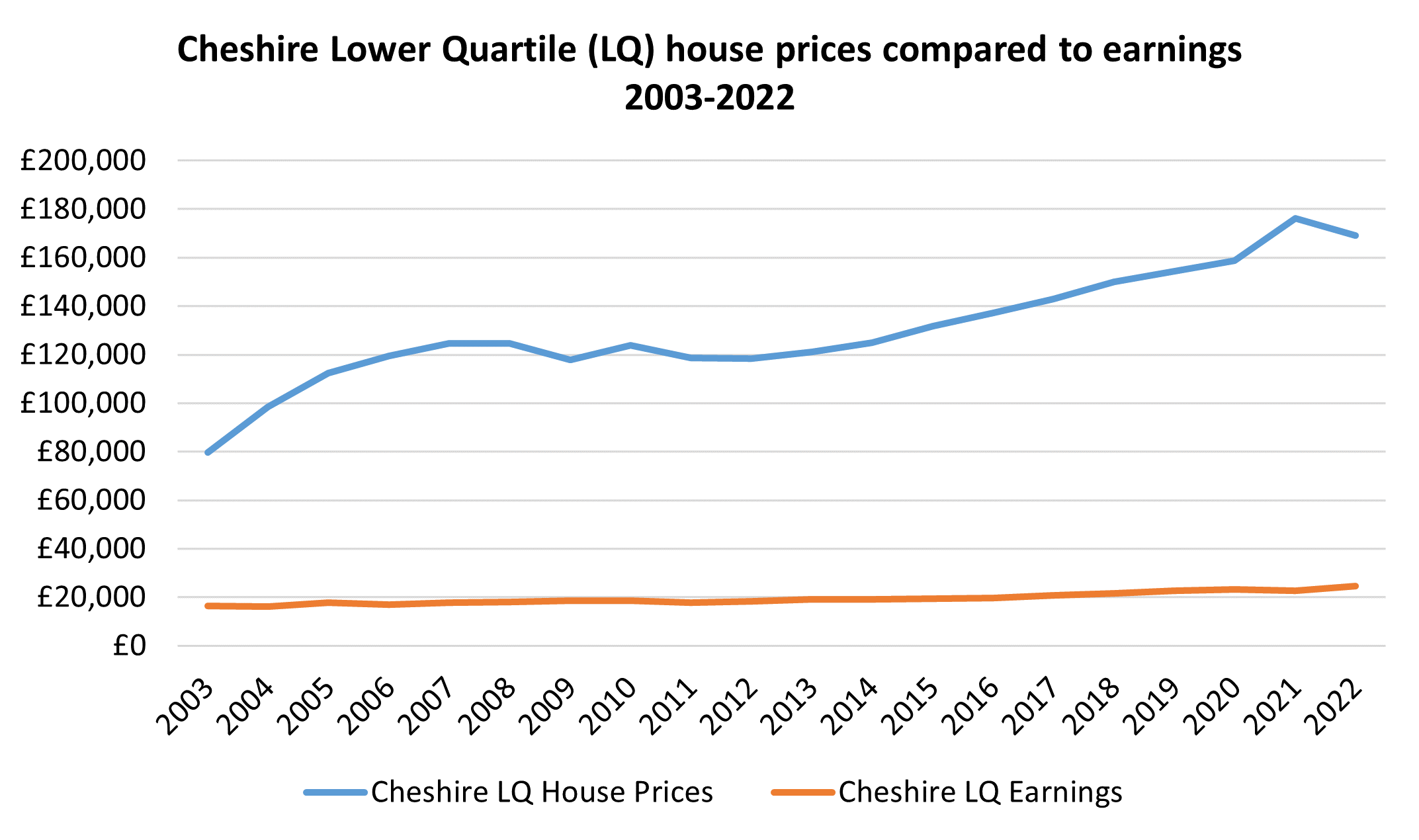The challenge of working with rural communities to secure genuinely affordable housing
5 July 2023
John Heselwood, Policy & Development Manager for Cheshire Community Action, provides a guest blog for ACRE describing the circumstances that make it difficult for rural communities to secure the homes they need and what can be done about it.
For this year’s #RuralHousingWeek, ACRE invited Cheshire Community Action to provide a local perspective from our rural housing enabling work with communities, developers, landowners and local authorities to assess housing need and bring forward sites suitable to meet those needs.
In Cheshire, similar to many other rural areas, there are some challenging issues that are creating barriers to the delivery of affordable rural housing.
A surge in rural house prices in recent years combined with stagnant wages and a cost of living crisis has further exacerbated a ‘decades old’ problem of housing affordability in rural areas. In Cheshire, the gap between earnings and house prices has continued to grow over the past two decades; a trend that is repeated across the country.

Part of the problem is that current solutions defined as ‘affordable tenures‘ (such as affordable or social rent, shared ownership, discounted sales, First Homes and Rent to Buy) are anything but in today’s overheated housing market. The feedback we receive from communities increasingly points towards an awareness that the affordable tenures available are merely ‘workarounds for a broken system’ which don’t seem to plug the gap between wages and housing costs.
This viewpoint is also reflected in the evidence we see captured in housing needs surveys. These are research projects that we support, which document local residents’ need for housing. In recent years, surveys produced in Cheshire have shown a significant drop in demand for shared ownership tenures. Affordability assessments also show that in many rural areas, affordable rent set at 80% of market rates and sales discounted at a similar rate are simply not affordable to lower income households.
Another challenge for smaller rural settlements is that large strategic developments are thought to ‘absorb’ housing need across rural areas by volume developers. Yet, our surveys still demonstrate parish-level housing need, despite their proximity to large developments, which raises the question whether larger sites are sufficiently meeting the local need in smaller rural settlements.
The same proliferation of larger housing developments in Cheshire is also creating more opposition to housing developments from local communities. But this is not about traditional ‘NIMBYs’. In our experience, the rural communities we engage are not necessarily against housing developments. Rather they are concerned about what gets built and where.
People are asking legitimate questions about the true affordability of housing – not just the strategic numbers needed, but whether it is genuinely affordable and provides an appropriate mix, type, tenure to meet local community need. Many communities we work with have produced neighbourhood plans, which support (quite rightly) more granular, small-scale applications for housing development which fit in with the needs and circumstances of the local area. The evidence generated by neighbourhood plan groups is often at odds with the large-scale commercial housing that gets built.
Larger volume developments also create a gravitational pull for over-stretched development teams. In other words, development of a 10 unit site in a small village is much less attractive to the finance directors of housing associations than a 200-300 unit site that can deliver bigger economies of scale. This makes financial sense in the context of increased construction costs and delivers much higher numbers, thereby providing a faster route to achieving local authority housing targets. But this also creates another hurdle for rural communities to deliver the mix of homes that are needed. Combined with the tendency for planning policy to direct residential developments towards larger villages and settlements deemed sustainable (due to the presence of certain services) they have accelerated the decline of some smaller rural settlements in Cheshire.
However, despite these challenges, there are examples of housing associations working in partnership with community-led housing groups to overcome these barriers and deliver genuinely affordable homes. A growing number of CLH developments are being brought about by groups that have worked against the odds to deliver more affordable homes such as the Tattenhall Community Land Trust (CLT) in Cheshire.
The CLH sector has great potential to grow – by up to 30,000 homes on rural exceptions sites according to the latest CLT State of the Sector Report. By itself, CLH is unlikely to meet the scale of demand being felt across the country, but it can positively disrupt the current trend of growing unaffordability and become a viable mainstream option for communities with the right support and investment for the sector.
These are difficult issues to solve but not insurmountable with a concerted effort from stakeholders and policy makers to work together to increase the supply of genuinely affordable housing, help tackle poverty, and boost the economy in rural areas. Based on my experience, the following policy measures would help:
- A review of affordable tenures that simplifies rent and home ownership options for households and enables developments to better respond to local need with a more flexible funding regime that accounts for local income levels and circumstances.
- Policy incentives for landowners, developers and housing associations to develop small rural housing sites that respond to local need in terms of affordability, mix, type and tenure. E.g. Rural Exception Site Planning Passports as supported by ACRE and CLA, and Community-led Exception sites as proposed by the CLT Network.
- Renewing the Community Housing Fund to provide the resources needed to stimulate and support the growth in community-led developments.
- Local Plans to place more emphasis on housing need in terms of mix, size, type and tenure, and how this is being met (including how large developments impact and contribute to local infrastructure and services) to enable more accountability of planning decisions and developers.
- Continued financial and technical support for neighbourhood plan groups to enable communities to create and influence planning policy more effectively within their local areas.
The recent government announcement of funding for rural housing enablers is a welcome and timely injection of resources to help boost delivery of affordable rural homes. But with many marginal rural constituencies set to be key battlegrounds in the upcoming general election, it will be interesting to see whether the hopeful politicians will take decisive action on the more structural policy and funding issues to address this most pressing rural concern.
This blog was prepared for #RuralHousingWeek, a week-long campaign discussing the #HousingCrisis in #rural communities, and what can be done about it.



